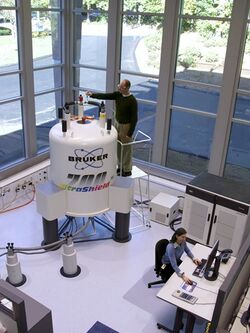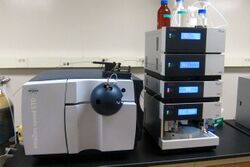Bruker
Topic: Company
 From HandWiki - Reading time: 7 min
From HandWiki - Reading time: 7 min
 | |
| Type | Public company |
|---|---|
| Industry | Scientific test equipment |
| Founded | 1960 in Germany |
| Founder |
|
| Headquarters | Billerica, Massachusetts, U.S. |
Key people | Frank Laukien, President & CEO; William Knight, COO |
| Revenue | |
Number of employees | 7,400 (2020) |
| Website | bruker |
Bruker Corporation is an American manufacturer of scientific instruments for molecular and materials research, as well as for industrial and applied analysis. It is headquartered in Billerica, Massachusetts, and is the publicly traded parent company of Bruker Scientific Instruments (Bruker AXS, Bruker BioSpin, Bruker Daltonics and Bruker Optics) and Bruker Energy & Supercon Technologies (BEST) divisions.
In April 2010, Bruker created a Chemical Analysis Division (headquartered in Fremont, CA) under the Bruker Daltonics subsidiary. This division contains three former Varian product lines: ICPMS systems, laboratory gas chromatography (GC), and GC-triple quadrupole mass spectrometer (originally designed by Bear Instruments and acquired by Varian in 2001).
In 2012, it sponsored the Fritz Feigl Prize,[2] and since 1999 the company has also sponsored the Günther Laukien Prize.[3]
History
The company was founded on September 7, 1960, in Karlsruhe, Germany[4] as Bruker-Physik AG[3] by five people, one of them being Günther Laukien, who was a professor at the University of Karlsruhe at the time. The name Bruker originates from co-founder Emil Bruker, as Günther Laukien himself was formally not allowed to commercialize his research whilst being a professor.[4] Bruker produced Nuclear Magnetic Resonance Spectroscopy (NMR) and EMR spectroscopy equipment then.
In the early 1960s, the company had around 60 employees and was growing rapidly.[5] One of the early success products was the HFX 90 NMR spectroscopy system, with three independent channels and which was also the first NMR system using only semiconductor transistors.[6]
In 1969, Bruker launched the first commercial Fourier transform NMR spectroscopy system (FT-NMR) and in the 1970s the company was the first to commercialize a superconducting FT-NMR. Later, the company would expand their product range with MRI, FTIR and FT-Raman spectrometers and with mass spectrometers.[7]
In 1968, Bruker shipped NMR systems to Yale University in Connecticut. After that, demand from the US grew, so Bruker opened an office in Elmsford, New York which marked the start of their US activities.[4] In 2008 after a corporate reorganization lasting 8 years, all divisions were merged in a unified Bruker Corporation.[4]
Günther Laukien died in 1997; one of his four sons Frank Laukien, is currently the CEO of Bruker.[7] Another son, Jörg C. Laukien, also works for the company.[8] Another son, Dirk D. Laukien, is a former company executive.[9]
Acquisitions
Bruker acquisitions include GE NMR Instruments (1992), Siemens AXS (1997),[10] Nonius (2001),[11] MacScience (2002),[12] Vacuumschmelze Hanau (2003),[13] Röntec (2005),[14] SOCABIM (2005),[15] PGT (2005),[16] Keymaster (2006),[17] Quantron (2006),[18] JuWe (2008),[19] SIS (2008),[20] ACCEL (2009),[21] Michrom Bioresources (2011),[22] Skyscan (2012),[23] Prairie Technologies (2013),[24] Oncovision (Preclinical PET imaging business, 2016),[25] Oxford Instruments Superconducting Technology (2016),[26] Hysitron Inc. (2017),[27] XGLab (2017),[28] Luxendo (2017),[29] Alicona (2018),[30] PMOD Technologies LLC (2019),[31] Optimal Group (2022),[32] and Neurescence Inc (2022).[33]
Other
In 1964, the company bought the NMR division of the Switzerland Trüb-Täuber.[3]
Bruker made several offers to take over its supplier Oxford Instruments during the 1970s, but after almost a decade of negotiations, an acquisition was eventually rejected by Oxford Instruments.[34]
In 1997, the analytical X-ray division of Siemens was acquired by Bruker.[35]
In 2010, Bruker bought 3 product lines from Agilent, which Agilent had acquired from Varian.[36] These included mass spectrometry and gas chromatography instruments. They have since divested these products to Scion Instruments with the exception of the triple quadrupole[citation needed]
In 2012, Bruker bought parts of Carestream Health, including their in-vivo imaging portfolio and related aspects.[37]
In 2019, Bruker bought Alicona, known for production of metrology equipment based on focus variation, to extend its analytics business in the industrial market.[38]
In November 2022, it was announced Bruker had acquired the Mountain View-headquartered miniaturized microscope / miniscope company, Inscopix, Inc.[39]
Products
Bruker develops and delivers a wide variety of professional and scientific analysis devices including mass spectrometers, single-Crystal and powder X-ray diffractometers, X-ray tomography devices, NMR spectroscopy devices, fluorescence microscopes, raman spectroscopes, atomic-force microscopes, and profilometers
Notable product use
Bruker products are used globally in a variety of situations. The National High Magnetic Field Laboratory at Florida State University selected Bruker to build the world's first 21.0 tesla FT-ICR MS.[40]
The Total Carbon Column Observing Network uses high resolution FT-IR spectrometers made by Bruker to measure various greenhouse gases across the globe.[41]
Awards
In May, 2004, Frost & Sullivan selected the Company's Bruker Daltonics subsidiary for their 2004 Product Line Innovation Award for the Life Sciences. Bruker Daltonics received this award for its innovative development of sophisticated mass spectrometers.[42]
References
- ↑ "Error: no
|title=specified when using {{Cite web}}". https://s22.q4cdn.com/617463959/files/doc_financials/2022/ar/2022-Bruker-Annual-Report.pdf. - ↑ "Fritz-Feigl-Preis". http://www.asac.at/Index.aspx?site=1&main=84&sub=0&content=313.
- ↑ 3.0 3.1 3.2 Ernst, Richard R. (2005). "The Günther Laukien Prize". Journal of Magnetic Resonance 173 (2): 188–191. doi:10.1016/j.jmr.2005.02.006. ISSN 1090-7807. PMID 15780911. Bibcode: 2005JMagR.173..188E.
- ↑ 4.0 4.1 4.2 4.3 Burgäzy, Frank (21 September 2010). "17th Bruker Users' Group Meeting 2010 Single Crystal X-ray Diffraction". Bruker AXS. http://xray.chem.wisc.edu/Resources/Meetings/Bruker18/01_welcome%20scd%20user%20meeting%20bio.pdf.
- ↑ Gareth R Eaton; Sandra S Eaton; Kev M Salikhov (8 May 1998). Foundations of Modern EPR. World Scientific. p. 718. ISBN 978-981-4496-81-0. https://books.google.com/books?id=PBjtCgAAQBAJ&pg=PA718.
- ↑ Longo, Michelle. "The 1960s". Laboratory Equipment. http://www.laboratoryequipment.com/articles/2013/06/1960s. "Bruker ultimately introduced the first fully transistorized NMR instrument, the HFX 90, the first of which was delivered to the Technical Univ. of Berlin."
- ↑ 7.0 7.1 "Bruker's Founder, Günther Laukien, Honored at Pittcon 2013". 22 May 2013. http://www.theresonance.com/gunther-laukien-honored-2/.
- ↑ "Corporate Governance". Bruker. http://ir.bruker.com/investors/corporate-governance/officers-and-directors/default.aspx.
- ↑ "Joerg C. Laukien". Bruker. http://ir.bruker.com/investors/corporate-governance/officers-and-directors/biography/default.aspx?ItemId=bf3a7418-37e8-4b24-aea0-a623615e66de.
- ↑ "History of Bruker". Bruker. https://www.bruker.com/about-us/who-we-are/whoweare/history.html.
- ↑ "Bruker AXS and Nonius unite". International Union of Crystallography. http://www.iucr.org/news/newsletter/volume-9/number-1/bruker-axs-and-nonius.
- ↑ Bruker AXS Acquires MAC Science to Further Penetrate Japanese Life Science and Materials Research Markets.. (n.d.) >The Free Library. (2014). Retrieved Mar 08 2016 from http://www.thefreelibrary.com/Bruker+AXS+Acquires+MAC+Science+to+Further+Penetrate+Japanese+Life...-a084889567
- ↑ "Bruker BioSpin Announces Agreement To Acquire Superconductor Business". BusinessWire. 21 May 2003. http://www.businesswire.com/news/home/20030521005367/en/Bruker-BioSpin-Announces-Agreement-Acquire-Superconductor-Business.
- ↑ "Bruker AXS enters x-ray microanalysis market." Instrument Business Outlook. Strategic Directions International Inc. (SDI). 2005. "Archived copy". https://www.highbeam.com/doc/1G1-138313230.html.
- ↑ "Bruker AXS to Acquire X-Ray Analysis Software Company SOCABIM". BusinessWire. 16 August 2005. http://www.businesswire.com/news/home/20051026005248/en/Bruker-AXS-Announces-Agreement-Acquire-Princeton-Gamma-Tech.
- ↑ "Bruker AXS Announces Agreement to Acquire the Princeton Gamma-Tech (PGT) X-Ray Microanalysis Business". BusinessWire. 26 October 2005. http://www.businesswire.com/news/home/20051026005248/en/Bruker-AXS-Announces-Agreement-Acquire-Princeton-Gamma-Tech.
- ↑ "Bruker AXS Announces Acquisition of Hand-held XRF Company". BusinessWire. 20 June 2006. http://www.businesswire.com/news/home/20060720005046/en/Bruker-AXS-Announces-Acquisition-Hand-held-XRF-Company.
- ↑ "Bruker AXS Acquires Metals Analysis Company". Photonics.com. 8 September 2006. http://www.photonics.com/Article.aspx?AID=26756.
- ↑ "Bruker AXS Announces Agreement to Acquire Elemental Analysis Company JUWE Laborgeraete GmbH". BusinessWire. 3 January 2008. http://www.businesswire.com/news/home/20080103005448/en/Bruker-AXS-Announces-Agreement-Acquire-Elemental-Analysis.
- ↑ Wilkinson, Matt (22 August 2008). "Bruker AXS Announces Acquisition of Hand-held XRF Company". http://www.in-pharmatechnologist.com/Processing/Bruker-forces-its-way-into-the-AFM-market.
- ↑ "Bruker Advanced Supercon, Inc. Acquires ACCEL Research Instruments Business from Varian Medical Systems". 3 April 2009. https://www.reuters.com/article/idUS97095+03-Apr-2009+BW20090403.
- ↑ Dunlap, Lloyd (April 2011). "Bruker acquires Michrom Bioresources". DDN-News. http://www.ddn-news.com/index.php?newsarticle=4769.
- ↑ "Bruker Acquires Skyscan MicroCT". http://www.bruker.com/products/mr/news/single-view/article/bruker-announces-acquisition-of-skyscan-a-leading-provider-of-micro-ct-systems-for-3d-x-ray-imaging-1.html.
- ↑ "Bruker Announces Acquisition of Prairie Technologies". September 12, 2013. http://www.bruker.com/news-records/single-view/article/bruker-announces-acquisition-of-prairie-technologies.html.
- ↑ "Bruker Completes Acquisition of Preclinical PET Imaging Business". November 22, 2016. http://www.bruker.com/news-records/single-view/article/bruker-completes-acquisition-of-preclinical-pet-imaging-business.html.
- ↑ "Bruker and Oxford Instruments Announce Acquisition of Oxford Instruments Superconducting Wire Business by Bruker's BEST Segment". Bruker. 17 November 2016. https://ir.bruker.com/m/#/Press_Releases/acd26933-3793-4f9c-af17-e38d10989a12.
- ↑ "Hysitron Joins Bruker Nano Surfaces Division - Hysitron" (in en). https://www.hysitron.com/hysitron-joins-bruker-nano-surfaces-division.
- ↑ "Bruker Acquires Company XGLab with Unique X-Ray Detection Technologies and XRF Instruments for Art & Conservation Markets". https://ir.bruker.com/investors/press-releases/press-release-details/2017/Bruker-Acquires-Company-XGLab-with-Unique-X-Ray-Detection-Technologies-and-XRF-Instruments-for-Art--Conservation-Markets/default.aspx.
- ↑ "Bruker Acquires Emerging Light Sheet Microscopy Company LUXENDO". May 8, 2017. https://luxendo.eu/news-events/news/2017/05/08/bruker-acquires-emerging-light-sheet-microscopy-company-luxendo/.
- ↑ Editor, Keith Mills Publishing (November 14, 2018). "Bruker to Acquire Alicona Imaging". https://metrology.news/bruker-corporation-to-acquire-alicona-imaging/.
- ↑ Corporation, Bruker. "Bruker Announces Acquisition of Preclinical and Molecular Imaging Research Software Provider PMOD Technologies LLC". www.prnewswire.com (Press release). Retrieved 2021-07-22.
- ↑ "Bruker acquires Optimal Group" (in en). https://www.manufacturingchemist.com/news/article_page/Bruker_acquires_Optimal_Group/200381.
- ↑ "Bruker to Acquire Neurescence". https://www.optica-opn.org/home/industry/2022/november/bruker_to_acquire_neurescence/.
- ↑ Audrey Wood (25 January 2001). Magnetic Venture: The Story of Oxford Instruments. OUP Oxford. pp. 94–95. ISBN 978-0-19-924108-8. https://books.google.com/books?id=n1x9IXEBtQMC&pg=PA94.
- ↑ "Business: Bruker acquires Siemens". Analytical Chemistry 69 (23): 715A. 1997. doi:10.1021/ac9718612. ISSN 0003-2700.
- ↑ "Bruker and Agilent Technologies Announce Agreement for Bruker to Acquire Certain Varian Inc. Product Lines". March 9, 2010. http://www.agilent.com/about/newsroom/presrel/2010/09mar-gp10008.html.
- ↑ "Bruker to Acquire Carestream's Preclinical In-vivo Imaging Business". September 21, 2012. http://www.carestream.com/publicNewsEventsArticle.aspx?vertical=news&id=455081.
- ↑ "Bruker to acquire Alicona Imaging GmbH" (in en). https://www.todaysmedicaldevelopments.com/article/bruker-acquiring-alicona-metrology-112618/.
- ↑ "Bruker Announces Acquisition of Inscopix for Neuroscience Research" (in en-US). 2022-11-09. https://www.nsmedicaldevices.com/news/bruker-announces-acquisition-of-inscopix-for-neuroscience-research/.
- ↑ "Bruker Daltonics Chosen to Build World's First 21.0 Tesla FT-ICR Magnet". Genetic Engineering and Biotechnology News. October 29, 2010. http://www.genengnews.com/gen-news-highlights/bruker-daltonics-chosen-to-build-world-s-first-21-0-tesla-ft-icr-magnet/81244156/.
- ↑ Toon, Geoffrey; Blavier, Jean-Francois; Washenfelder, Rebecca; Wunch, Debra; Keppel-Aleks, Gretchen; Wennberg, Paul; Connor, Brian; Sherlock, Vanessa et al. (March 23, 2009). Total Column Carbon Observing Network (TCCON). http://www.tccon.caltech.edu/publications/OSA_FTS_Meeting_20090323.pdf. Retrieved 12 March 2014.
- ↑ "Frost & Sullivan Presents 2004 Product Line Innovation Award to Bruker" (Press release).
External links
 |
 KSF
KSF


